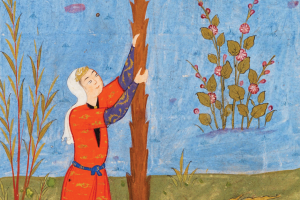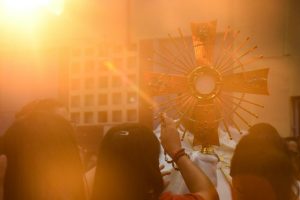A good liturgy draws people in, challenges them, allows them to pariticpate, and gives a sense of awe, Father Keith Pecklers, S.J. says in this interview from May 2007.
As a professor of liturgy at Rome's Pontifical Liturgical Institute, Jesuit Father Keith Pecklers has a unique perch from which to view the current liturgical controversies. "I've gotten to the point where I can read a Vatican document and have a sense of which part of the world it's directed at," he says. He points out that a recent rule directing the presider to offer the sign of peace only to those close by might be directed more at Italy, where the peace can go on for 10 minutes, than at the United States.
What is key for Pecklers, however, is that the assembly celebrating the liturgy connects what goes on inside church with the world outside. "You can have the most beautiful liturgy in the world, but if you don't have people on board, it won't matter," he says. His own efforts to make that happen include co-founding Caravita, an international Catholic community that meets in Rome's St. Francis Xavier Caravita Church.
Still, Pecklers is concerned by the trend toward the liturgical past. While acknowledging that today's liturgy isn't perfect, going back is no solution. "The pre-Vatican II liturgy was as idiosyncratic as the post-Vatican II liturgy, but in different ways. There's no golden age there either."
We Catholics talk a lot about the centrality of the Eucharist, but do you think everyday Catholics, even priests, really get what Mass is all about?
I still am not convinced that 40 years after the second Vatican Council the average Catholic actually grasps what it is that we're being called to when we go to Mass on Sunday.
I think perhaps those of us who are clergy, pastoral ministers, or liturgical leaders take too much for granted, even when it comes to basic things like why it is important that we sing, why it is important that we recite the Creed or the Gloria when half of the assembly isn't. Why does that matter?
Why is it important? Why sing?
Active participation in the liturgy is about professing that we believe. I look around at Mass and wonder if we really believe that Christ is risen. The simple answer to your question is why shouldn't we sing: We sing because Christ is risen, because we presumably believe it, or we wouldn't be at Mass.
I think we still have the idea that we go to church because that's what Catholics do, that we're fulfilling our obligation. People don't talk that way, but I think it's still hi the back of our minds. When people ask why we need to go to church when we can pray any tune, I always say that from the earliest centuries of Christianity, to be a Christian has meant to be together on the Lord's day. We need to hear the baby crying next to us or see that old person on the other side of the church, because we're linked together and it's not just about us as individuals.
How does that connection affect us?
What I'm talking about is liturgy transforming moral behavior, liturgy shaping the way we think and act. A professor from Notre Dame, recently deceased, used to ask whether we find ourselves living any differently this week because of having been to church. The honest answer for most people is no. But I can remember experiences at parishes where I felt so nourished by the preaching, by the singing, by the participation, by the worship itself, that I would look forward very much to the following week, to be back there in that community.
Are there aspects of our current culture that make it harder for liturgy to foster that connection?
If you're talking about North America, immigration is a key one. Our parishes are evolving multiculturally, and really celebrating together can be a challenge in a parish that has both immigrant and native-born Americans of different ethnic and cultural backgrounds. That obviously is something quite different from 40 years ago when the second Vatican Council launched the liturgical reform.
The other reality is demographic, specifically the many divorced and remarried Catholics, gays and lesbians, and other different groups of people who are on the edges of the church. How are we reaching these people?
We also have an increasing number of lay Catholics who are very well educated theologically, which is a wonderful gift, fust think of the number of women who are doing graduate degrees in theology and the number of lay Catholics involved in adult education groups. What happens of course is that in some situations, you have very intelligent lay Catholics who have to endure week after week of poorly prepared homilies or in some cases homilies that are condescending, patronizing, or simply out of touch with their experience.
A third challenge is the fact that not only in Latin America, but increasingly in the United States and Canada, and now also in Europe, there are people leaving the church, many in favor of more fundamentalist communities. We know of the migration of Anglicans toward the Roman Catholic Church, largely over the ordination of women, but what has been largely underreported is the number of departures from the Catholic Church to Anglicanism, largely over issues where the church's credibility has been called into question. I think we need to be asking ourselves what we are not doing and what we could be doing in order to reach these people.
Does liturgy exacerbate some of the realities that you identify in either driving people away or bringing them in? Or is it not liturgy's problem?
It is liturgy's problem, especially for those responsible for its preparation and execution. Whether this is right or wrong, I think it's true that much of the liturgy rises and falls on the quality of the homily. If we hear a good homily, we can put up with quite a bit in the rest of the Mass. But a negative or exclusive message is going to drive people away. Very concretely, if someone is ranting and raving about the divorced and remarried, and somebody's sitting there who is divorced, that person may remain and roll his or her eyes or the person may eventually move on.
What does a good liturgy look like?
Good liturgy happens when everyone is on board, everyone is participating, the ritual functions well, the music is well prepared, the preaching is good, and there is both a sense of transcendence and immanence. You're drawn into the sense of mystery and awe, and at the same time it's not removed from life.
There are parishes that do this consistently well. I walked into a church in Munich, Germany maybe 10 years ago for a Sunday Mass, and I noticed that the first thing people did was go over to the baptismal font and bless themselves, even though the font was in an alcove. As soon as the Mass began, it was an overwhelming experience. Everyone had hymn books in their hands, booming out the music.
I didn't know anything about the history of the church but I knew there must have been a few very good pastors there. I went back and did my homework and found out that it was Romano Guardini's church; he was one of the pioneers of the liturgical movement who was living in Munich in the 1920s, '30s, and '40s. This was 1995.
You mention transcendence as one aspect of good liturgy. Many people say that after Vatican II we lost that. Do you think that's true?
I actually agree with much of that critique. A lot happened very quickly after the council. The fact that we had all the prayers translated from Latin in only four years is pretty amazing, and therefore the results, which are rather uneven, should not surprise us.
When we started worshiping in English, we also began talking our way through everything. I remember as a kid the commentators with constant announcements throughout Mass, "Please stand for the Good News," for example. I remember thinking, "This isn't good news at all!"
One of the problems of the Vatican II liturgy is that it has evolved in many places into something that can become too mundane, too self-referential, leaving little room for awe and mystery.
I think we can be mainstream Catholics and still long for awe and mystery, even try to recover it, for example, by not putting words on top of words on top of words but attending to silence. Incense on holy days or on Sunday need not be seen as a conservative gesture.
We have in some ways bought into the kind of efficiency model of consumer culture. We want to do what's expeditious. Some people don't want to give the cup to the people because it takes too long or is too complicated. We don't want to take time after Communion because people want to get out.
Is there a middle ground between awe and mystery and the more down-to-earth feel of many parish liturgies?
The example I use is Grace Cathedral, the Episcopal cathedral in San Francisco. The church reeks transcendence when you walk into it. The liturgy is beautifully celebrated, the people are fully participating, so it's awe-filled and mysterious, but it's also very earthy and very real, especially the preaching. There's not a sense of phoniness about it or a disconnect between the people and the liturgy. That same parish has extraordinary social outreach ministry.
For me the middle ground is liturgy that is prayerfully celebrated, that draws us in through our symbols–the sprinkling of water, the blessing and sharing of bread and wine–into the mystery of God that is beyond us. But the mystery I'm talking about is not disconnected from life.
Beyond just good preaching, how can we better draw people into Mass?
Obviously music is key. Many parishes sometimes choose music that isn't very singable. I like much contemporary church music, but I notice that classic hymns that are easy to sing are being used less and less, and that can discourage people from participating.
A study that has yet to be done is this whole question of why women sing more at church than men. How is it that men have absolutely no inhibitions screaming and hugging each other at a football game, which is ritual too, but when we move to liturgy they don't?
Part of it's probably cultural: If you're a man it's not cool to sing–except in the shower! Men are not supposed to be forthright about their feelings, particularly in front of other people; obviously when you're singing you're revealing something about yourself to other people, a certain conviction, your love for God.
Context is very important. If music or liturgy is too cute or sweet, it may work well with children but probably not with adult men. I guess it's about knowing your audience.
One response has been the way some parishes have a variety of liturgical styles that appeal to different groups. There's a liturgy on Sunday evening at a church on Park Avenue in New York that New York magazine picked as one of the 10 best places to find a mate. Not surprisingly the church is packed. That parish has been quite successful in learning how to reach young adults, and they turn up because the liturgy is credible.
On a given Sunday in a parish, there may be a more quiet Mass, a more solemn Mass, a more contemporary one. Sometimes there's a danger of giving people what they want, of course, but it is still possible to communicate in a way that's both authentic to the liturgy and accessible to the people who are there.
Does that mean we should also split up the different cultural groups?
Context dictates to a certain degree the need for variety, and I think that's OK. It makes sense to me that a parish in a Hispanic community would have a Spanish Mass or several rather than having all of them bilingual. Why? Because on one hand it allows bonding within the Latino community, and it's also just more practical. It makes sense that there would be these different Masses, with the assumption that everyone is always welcome at any Mass.
It's expected that the pope will soon give permission for wider use of the Tridentine liturgy. Can we think of that liturgy as just another liturgical style to be offered?
No, for several reasons. In this case it's more than just the liturgical style that's being offered. Such a move would be an ultimate negation of Vatican II. It would say basically that Vatican II was not right in abolishing the Tridentine liturgical style.
Secondly, the real issue is actually not the liturgy but ecclesiology, the way we understand what and who the church is. I think that those who want the old liturgy back never accepted the ecclesiology of Vatican II. The language of being a pilgrim church, for example, implies not having it all figured out, having more questions than answers. It implies a certain equality because a rich and famous lawyer and an uneducated person are on the same pilgrimage together.
So, were we to move back to the Tridentine liturgy, it would not only be a negation of Vatican II's liturgical reform but a negation of Vatican II's ecclesiology. That's the fear on the part of a number of cardinals and bishops, and several cardinals have directly asked the pope not to expand the permission.
Having written about the "liturgical movement" of the early 20th century that set the stage for Vatican II's reforms, how do you think those early pioneers would judge where their work has ended up?
I think they would agree with some of the critique on the part of the more conservative voices who are calling for a recovery of the mystical and transcendent. But I also think they would be pleased at the kind of lay ownership that currently is present in many places, which has been one of the most successful elements of the reform.
At the same time, I think they would lament the fact that in general their call to a socially conscious worship really hasn't taken hold. Of course you'll find some great examples of parishes where it has taken hold, but I rarely hear a prayer for the people of Iraq, for example, or a prayer for the Muslims during Ramadan. I hear prayers for those in the armed forces, for their health and safety–and by all means we should be praying for that–but if we really believe in God's mission in the world, of which we're a part, we should be praying not only for the Iraqi people but for terrorists and all those we see as enemies. Those kinds of connections need to be made, and yet I'm not always so convinced that we do it.
How can we strengthen the connection between liturgy and justice?
The justice connection gets made in how we treat the elderly or the infirm or the poor or the foreigner. The liturgical scholar Mark Francis asks how often we see a person in a wheelchair proclaiming a reading.
At a Jesuit community liturgy on Holy Thursday with the superior presiding, an attendant from the infirmary brought in a priest in a wheelchair during the first reading and left him in the back corner of the chapel behind a pole. So the superior, being a good Jesuit, broke all the liturgical rules and got up during the reading and wheeled that man up to the front of the chapel, in the middle of everything.
The liturgical purists would say the presider was upstaging the reader. Why didn't he wait until after the reading? But his instincts were right. There was no need to wash any feet that evening; that gesture alone embodied the connection between liturgy and justice.
The article appeared in the May 2007 issue of U.S. Catholic (Vol. 72, No. 5, pages 18-22).












Add comment